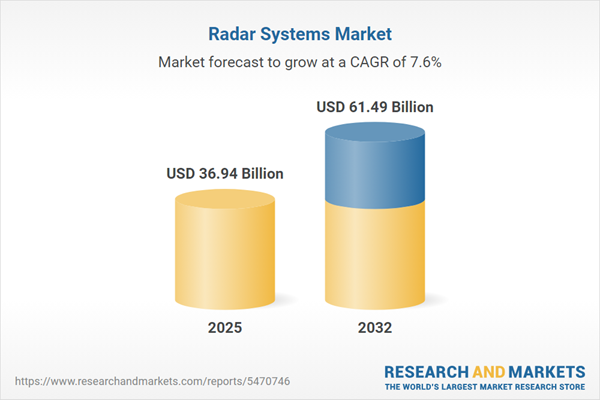Speak directly to the analyst to clarify any post sales queries you may have.
As the regulatory environment and industry complexities evolve, radar systems are emerging as mission-critical tools for organizational security, operational efficiency, and compliance in sectors ranging from infrastructure protection to emerging technology procurement. Senior executives are prioritizing adaptive radar solutions to ensure business continuity and accelerate modernization while navigating fast-changing requirements.
Market Snapshot: Radar Systems Market Size and Growth
The radar systems market, valued at USD 34.34 billion in 2024, is expected to reach USD 36.94 billion by 2025, with a compound annual growth rate of 7.55%. This growth reflects rising adoption in key sectors, including air traffic management, automotive safety, maritime navigation, and advanced weather monitoring. Industry expansion is driven by continuous technological upgrades, enhanced data analytics, and vendors’ commitment to regulatory alignment. As organizations seek scalable and innovative solutions, the stability of the radar systems market is further reinforced by efforts to address evolving compliance standards.
Scope & Segmentation: Comprehensive Radar Systems Market Overview
This report delivers a structured, segment-by-segment review of the radar systems market, supporting executive decisions in procurement, technology investment, and rapid adaptation to new industry norms. Each area covered is vital to understanding the value chain and targeting strategies that enhance organizational resilience and adaptability.
- Applications: Radar systems underpin mission-critical functions such as air traffic control, adaptive cruise control, defense surveillance, missile guidance, target tracking, naval navigation, and precision meteorological detection. Each application requires reliability to support both civilian and defense operations.
- Platforms: Coverage spans airborne options—including fixed-wing, rotary-wing, and unmanned solutions—alongside terrestrial, shipborne, submarine, and satellite-based deployments for integrated ground-to-orbit strategies.
- End Users: Major groups served include automotive manufacturers, aviation authorities, government defense agencies, marine operators, meteorological services, and telecommunications entities. Each operates under unique procurement structures and compliance frameworks.
- Frequency Bands: Radar system performance is optimized across C, Ka, Ku, S, and X bands to meet diverse operational and environmental needs.
- Technologies: System architectures include continuous wave, frequency modulated continuous wave, and pulse radar, with deployment options for coherent, non-coherent, and Doppler solutions to address technical and regulatory challenges.
- Regions: The analysis includes the Americas, Europe, Middle East & Africa, and Asia-Pacific, reflecting distinct investment patterns and certification dynamics relevant to each market.
- Competitive Landscape: The report evaluates Raytheon Technologies, Northrop Grumman, Lockheed Martin, Thales Group, Leonardo S.p.A., BAE Systems, L3Harris Technologies, Saab AB, Hensoldt AG, and Airbus Defence and Space to guide sourcing and partnership decisions.
Key Takeaways for Senior Decision-Makers
- Digital signal processing improvements and the integration of compact sensors are broadening radar system applications for transportation, security, and critical operational settings.
- Strategic alliances between defense organizations and technology companies are accelerating the market penetration of next-generation radar solutions.
- Adoption of software-defined and solid-state system architectures is simplifying modernization initiatives and enabling organizations to integrate complex radar systems more efficiently.
- Procurement practices are evolving regionally: North America concentrates on aerospace, EMEA emphasizes maritime and defense investments, and Asia-Pacific directs resources toward automotive safety and mobility advances.
- Modular procurement approaches are improving supply chain resilience and enabling organizations to respond quickly to compliance shifts and market changes.
- Engaging with local and regional suppliers has become critical to achieving regulatory certification and supporting efficient supply chains in regulated sectors.
Tariff Impact: Procurement and Supply Chain Strategy
Ongoing changes in US tariff policy are prompting radar system manufacturers to elevate local production and expand supplier networks. Modular system designs are instrumental in supporting seamless technology integration, while promoting procurement flexibility and strengthening supply chain efficiency. Collaboration between procurement and engineering teams remains essential for cost management and risk mitigation during regulatory adjustments.
Methodology & Data Sources
This radar systems market report is built on primary research through expert interviews, comprehensive supply chain analysis, and in-depth regulatory review. It employs technical document evaluation, patent research, and established methodologies such as SWOT, PESTEL, Porter’s Five Forces, and scenario modeling to deliver reliable insight for decision-making.
Why This Report Matters
- Equips technology and procurement leaders to confidently manage compliance shifts and leverage advancements in radar technology to enhance operational performance.
- Facilitates robust scenario planning and effective risk management across supply chains in critical operations and regulated industries.
- Offers practical market intelligence that helps executives steer investments and adapt organizations through regulatory or technological transitions.
Conclusion
This report provides senior leaders with strategic insight to navigate the evolving radar technology landscape. Leverage these findings to strengthen operational resilience, guide procurement decisions, and pursue new growth opportunities.
Additional Product Information:
- Purchase of this report includes 1 year online access with quarterly updates.
- This report can be updated on request. Please contact our Customer Experience team using the Ask a Question widget on our website.
Table of Contents
3. Executive Summary
4. Market Overview
7. Cumulative Impact of Artificial Intelligence 2025
Companies Mentioned
The companies profiled in this Radar Systems market report include:- Raytheon Technologies Corporation
- Northrop Grumman Corporation
- Lockheed Martin Corporation
- Thales Group
- Leonardo S.p.A.
- BAE Systems plc
- L3Harris Technologies, Inc.
- Saab AB
- Hensoldt AG
- Airbus Defence and Space SAS
Table Information
| Report Attribute | Details |
|---|---|
| No. of Pages | 199 |
| Published | October 2025 |
| Forecast Period | 2025 - 2032 |
| Estimated Market Value ( USD | $ 36.94 Billion |
| Forecasted Market Value ( USD | $ 61.49 Billion |
| Compound Annual Growth Rate | 7.5% |
| Regions Covered | Global |
| No. of Companies Mentioned | 11 |









